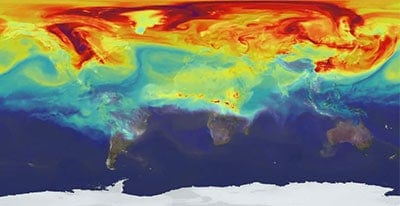The legacy of paleoclimate on modern biodiversity patterns is the subject of a new study by a team of researchers that includes UMass Amherst anthropologist Jason Kamilar. Their startling finding, that past climates are more important to the structure of mammal communities than modern climate, implies that African mammal species have either failed to move with their preferred environments over the last several thousand years of climate change, or that these species are ecologically flexible and can persist in a wide range of climatic conditions.
Scientists are increasingly concerned about the impact of climate change on the world’s biodiversity and have put great effort into forecasting the response of species to these changes over the next century. Research aiming to forecast species’ responses often assumes that species are adapted to current climate conditions and will follow their preferred climates during future climate change. However, this new study finds that the distribution of species today may largely be a product of the climate of the deep past, or paleoclimate.
If species have failed to move with their preferred environment through time to the present, then the researchers believe that there is a significant time lag between climate change and species’ response. Even worse, they say, this time lag occurs under natural rates of climate change—much slower than rates of anthropogenic climate change.
The study, published this month in the biological sciences journal Proceedings of the Royal Society B, was conducted by Kamilar, assistant professor of anthropology at UMass Amherst, John Rowan and Kaye Reed from Arizona State University’s Institute of Human Origins and Lydia Beaudrot of the University of Michigan.
The researchers statistically analyzed the relative influence of modern, mid-Holocene (~6,000 years ago) and Last Glacial Maximum (~22,000 years ago) climate on African mammal communities today. Their analysis shows that the structure of mammal communities across Africa today is actually more tightly linked to the climate of the mid-Holocene and Last Glacial Maximum than to modern climate. The mid-Holocene and Last Glacial Maximum are periods of climate extremes during the late Quaternary, with the mid-Holocene being warm and wet and the Last Glacial Maximum being cool and arid. These past climate changes drastically altered the distribution of vegetation in Africa (e.g., savannas, forests) and the mammal species that rely upon them.
The study examined how the community structures of three different mammal groups—carnivorans, like lions and hyenas; primates, like gorillas and baboons; and ungulates, like wildebeest and zebra—were influenced by modern and past climates. The researchers found that, unlike all other groups, primates have closely followed their preferred climates through time. This is because primates are highly dependent on forests for their survival and have shifted their distributions in response to the changing distribution of forests through wet and dry periods over the last 22,000 years. Carnivoran and ungulate communities, like mammals overall, are more closely linked with past climate.
“Primates are especially susceptible to climate change because most species are forest-adapted and these habitats decrease in size and become more fragmented when global temperatures rise,” Kamilar says, “and the rapid increase in global temperatures due to anthropogenic impacts will likely negatively impact primate populations as well as the other plants and animals that live in the high biodiversity regions of the Congo Basin.”
On the other hand, the second possibility offers a more optimistic point of view. If many African mammal species are ecologically flexible and can persist in a wide range of climate conditions, then they may be able to cope with future changes. However, the vastly faster rates of anthropogenic climate change casts doubt on this hopeful view.
“Our study relied on data during times of natural climate change, which occurs quite gradually. Yet, we have little idea if the current rapid increase in global temperatures will allow mammals, even ecologically flexible ones, to persist in the long-term,” says Kamilar.

